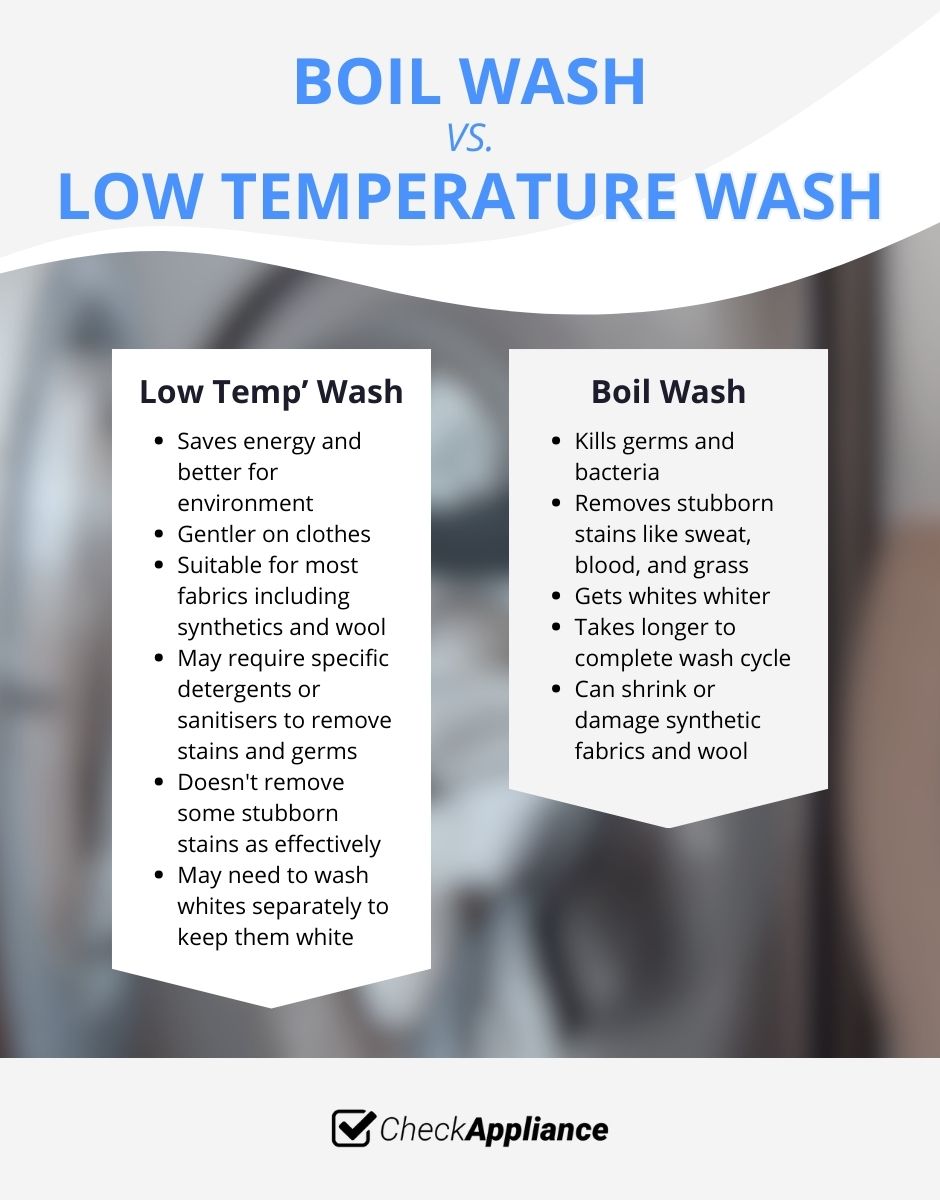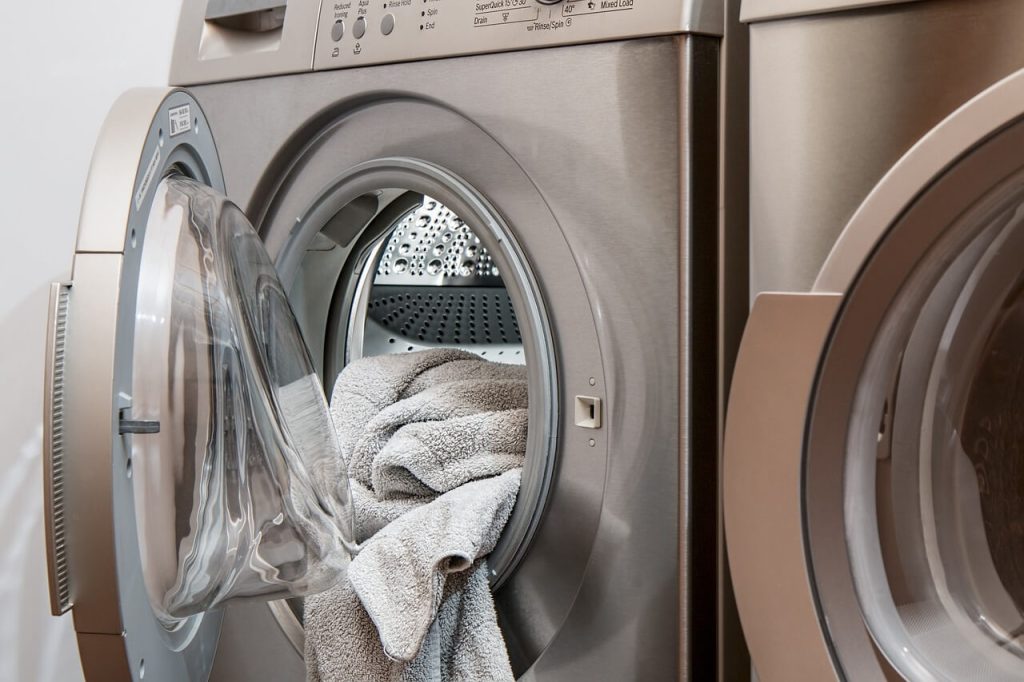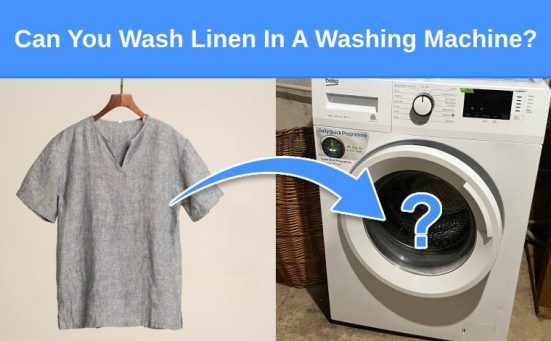
What Temperature Is A Boil Wash? (and what is it?)
Back in the old days before washing machines became commonplace in almost every home, boil washes were a regular thing. Of course back in those days detergents were almost non-existent and those that were available weren’t particularly good at removing germs and bacteria.
This meant that getting certain items properly clean required a boil wash. But what is a boil wash? And do we still need the boil wash? If you’re interested in finding out the answers to these questions, keep reading.
What Is The Temperature Of A Boil Wash?
As any scientist will tell you, water boils at 100°C and in the days before washing machines, laundry was literally washed in boiling water. This eliminated most germs and bacteria and ensured the clothes were clean.
Nowadays, we all have automatic washing machines and modern detergents that have all but eliminated the need for boil washes. However, most modern machines have a 90°C wash option. This is the closest we can now get to a boil wash unless you want to wash clothes by hand.
Even if you did hand wash your laundry, you’d be hard pushed to do it at boiling point unless you had a large cauldron on an open fire. This is because as soon as the water stops boiling, it loses heat at a pretty rapid rate.
What Is The Modern Equivalent Of The Boil Wash?
On modern washing machines, the nearest we can get to a boil wash is the 90°C wash. Whilst this isn’t exactly boiling point, it’s close enough when it comes to removing dirt, germs and bacteria.
Short of boiling water in a large pan on the hob and then adding your laundry to it once it is boiling, the 90°C wash on your washer is the best you can get.
Why Use A 90°C Wash Cycle?

A boil wash or hot wash at 90°C should be used for;
- Getting whites white
If you want to get your whites sparklingly white and don’t want to use bleach, washing them on a hot 90°C wash (fabrics permitting) will get them whiter than white. - Getting rid of stains
There are certain stains that will easily be removed using a 90°C wash. These include protein based stains as well as tomato and urine. - Removing bacteria
If you want to remove germs and bacteria from bedding, underwear or the clothes worn by somebody that’s ill, a 90°C wash will do the trick. - Cleaning The Washer
Most washing machine manufacturers advise running a service wash at 90°C at least once a month to remove any dirt, detergent residue, mildew or mould spores as well as germs and bacteria.
However, it’s worth mentioning here that a 60°C wash is often more than enough to remove many stains as well as many germs and bacteria.
Please Note:You should also always consult the wash care label on any items of laundry as many cannot withstand the high temperature of a boil wash.
Which Items Can Be Boil Washed?
The problem we face nowadays is that many items cannot withstand the high temperatures of a boil wash or a 90°C wash for that matter. In fact this cycle should really only be used to wash cotton or linen items as these are least likely to get damaged if exposed to the high 90°C temperatures.
This means you can usually wash towels, tea towels, bedsheets and other 100% cotton items in a 90°C wash without much risk of shrinking or other damage.
Which Items Cannot Be Boil Washed?
It is advisable to avoid washing the following items in a 90°C wash;
- Synthetic fabrics
- Blended fabrics
- Denim
- Wool
- Silk
As long as you limit your use of the boil wash or 90°C wash cycle to natural cotton and linen items like towels etc you shouldn’t get any problems from shrinkage or other damage. Whilst getting your clothes clean and bacteria free.
Is The Boil Wash Still Necessary?

There are a few issues associated with using a boil or 90°C wash cycle. These include;
- Energy usage
As the water is heated inside the washer by the heating element, the higher the water temperature required, the more energy used to achieve it. - Environmental issues
Using more energy has an impact on the environment. - Length of time taken
Boil washes or 90°C washes tend to take far longer than 20°, 30°, or even 40° wash cycles.
With the advent of cooler wash cycles, detergent manufacturers have developed detergents designed to be as effective at lower temperatures. This leads to the question: is the boil wash still necessary?
The answer is that, in many cases, no, the boil wash isn’t necessary. There are detergents available nowadays that can get clothes clean and germ free at temperatures as low as 20°C.
Plus there are also sanitisers available to ensure that all germs and bacteria are removed even at low temperatures.
That pretty much eradicates the need for a boil wash cycle (as long as you use the correct detergent and sanitiser).
Why Do Modern Washing Machines Still Have 90°C Wash Cycles?

You might be asking yourself why do modern machines still have 90°C wash cycles when modern detergents can clean clothes at way lower temperatures? The answer is because a 90°C wash is still the best way to ensure that the washer remains clean and germ free.
All washing machine manufacturers recommend running a 90°C wash cycle at least once a month to ensure the cleanliness of the machine. You can just run a hot wash cycle or you can add a specific cleaner/sanitiser to the hot wash cycle.
This will ensure all residue detergent/fabric softener, as well as all mould or mildew spores along with all germs and bacteria are eradicated from the washer.
SEE ALSO: What Temperature Is Considered A “Hot Wash”?
Frequently Asked Questions
Using the boil wash helps to remove many stains from clothes including; sweat, blood and grass. It can also help to return whites to their former glory. However, not all fabrics can withstand the rigours of high temperature washing. Check the wash care label before using the boil wash cycle.
On modern washing machines, the boil wash is the hottest cycle available. This is typically the 90°C wash.
60 degrees C is not the boil wash which is typically the 90 degree C wash. However, with the advent of modern detergents and sanitisers, the 60 degree C wash cycle is sufficient to remove stains as well as many germs and bacteria.




